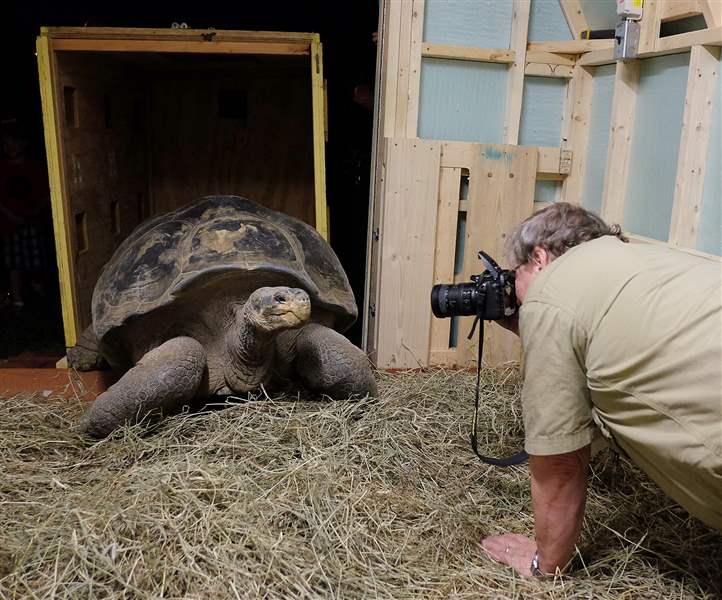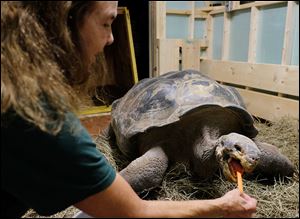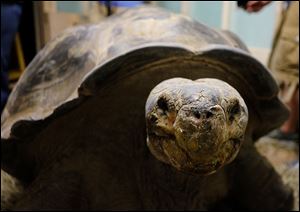
EMERSON EMERGES TO NEW FANS
‘Very majestic’ older tortoise finds new home at Toledo Zoo
8/28/2014
R. Andrew Odum, the Toledo Zoo’s curator of herpetology, photographs Emerson, the Galapagos tortoise, being delivered and unboxed. Emerson, estimated to be about 100 years old, arrived Wednesday evening.
THE BLADE/JEREMY WADSWORTH
Buy This Image

Val Hornyak offers a carrot to Emerson, a Galapagos tortoise, as he is delivered and unboxed at the Toledo Zoo. Emerson, a wild-born tortoise estimated to be 100 years old, arrived Wednesday evening.
Toledo’s newest exotic resident weighs 440 pounds, is old enough to be considered a living antique, and hails from a volcanic archipelago near the equator revered for its unique and diverse ecosystems.
Emerson, a dome-shelled Galapagos tortoise estimated to be about 100 years old, arrived at the Toledo Zoo on Wednesday evening from the San Diego Zoo. He was escorted by Toledo Zoo personnel on his FedEx flight to Detroit before being driven to Toledo and uncrated inside a heated shed, dubbed the “torta-bode,” for the night.
“He is a spectacular animal,” R. Andrew Odum, the Toledo Zoo’s curator of herpetology, said. “He’s a very majestic, statesman tortoise.”
Emerson arrived at the zoo about 8:30 p.m., greeted by a crowd of staff members. He emerged from his yellow wooden transport crate with no hesitation and explored his new surroundings. Handlers rewarded him with carrot and sweet potato treats and a neck rub.
Later this year, the zoo also will receive three 2-year-old Galapagos tortoises from the Gladys Porter Zoo in Brownsville, Texas. The trio, who do not yet have names, will be kept in the zoo’s hospital for their 60-day quarantine period before going on display in the Reptile House. Because of their much smaller size, they will not be housed with Emerson until they grow up a bit.
PHOTO GALLERY: Click here to view slideshow.
The young tortoises won’t be of breeding age until they are about 20 or 25 years old, but the zoo plans to participate in a breeding program with them.
Jeff Sailer, executive director of the Toledo Zoo, said visitors will be able to compare the hulking, centenarian Emerson to the young tortoises, which can be picked up with one hand. Families will watch the youngsters grow up and share that experience with several generations.
“The little ones could be here for 150 years or more,” Mr. Sailer said.
No one yet knows the average lifespan of a Galapagos tortoise because they live so long. Tracking the animals with known hatching dates takes several generations of humans, but experts estimate the giant reptiles may live anywhere from 150 to 200 years.

Emerson emerges from his wooden transport crate with no hesitation and explores his new surroundings at the Toledo Zoo. Zoo leaders say they hope to acquire a female companion for him.
Emerson is the zoo’s first Galapagos tortoise since 1983 when his predecessor, Galopy, was sent to San Diego by former Toledo Zoo director William Dennler at the recommendation of the Galapagos Tortoise Species Survival Plan. Galopy was also a wild-born tortoise and was the much-beloved face of the Toledo Zoo for 32 years. Many area residents have memories of riding atop the reptile’s dome shell in the Wonder Valley children’s zoo.
Link to Galopy
Galopy was tortoise No. 29 in San Diego. Emerson was No. 30, having arrived there the same year. The two were housed together with other members of the San Diego tortoise group.
“This tortoise knew Galopy, and knew him well,” Mr. Odum said. “So that’s pretty neat.”
Records from the San Diego Zoo indicate Galopy had been undergoing repeated diagnostic testing and treatment for extreme generalized edema. He died in the San Diego zoo’s hospital in March, 1995, at an estimated age of about 75. A definitive cause of death could not be determined, but the necropsy report suggested renal or thyroid disease as possibilities.
Galapagos tortoises, an endangered species, are one of the foremost examples of the impact of human activity on the natural world and are a common symbol of the need for conservation.
Because they can live for months without food or water, their populations were decimated in the 1800s when whalers rounded them up to store aboard ships as a reliable source of fresh meat.
Now, predators and habitat destruction from invasive species are the primary concern.
“These are one of the most terrific ambassadors of any species,” Mr. Odum said. “We are extremely excited to have them here.”
Tommy Owens, lead reptile keeper at the San Diego Zoo, knew and cared for Emerson for a little more than 13 years.
“We’re happy he’s going to a place where he can be an ambassador for Galapagos tortoises,” Mr. Owens said. “They are one of those animals in zoos that people most of the time wouldn’t have an opportunity to see otherwise. They leave an impression that lasts for a lifetime.”
Born in the wild
Emerson was born in the wild on the Galapagos Islands before being brought to the United States, so his age and history are only a best guess. Conflicting genetic tests to determine his subspecies indicate he is either a natural hybrid of tortoises from the Wolf and Alcedo volcanoes on Isabela Island or is from Santiago Island.
“He is unique genetically,” Mr. Odum said. “There is nothing in the United States similar.”

R. Andrew Odum, the Toledo Zoo’s curator of herpetology, photographs Emerson, the Galapagos tortoise, being delivered and unboxed. Emerson, estimated to be about 100 years old, arrived Wednesday evening.
The three youngsters will be of the subspecies from Darwin Volcano on Isabela Island.
Before being loaned to San Diego in 1983, Emerson was at the St. Louis Zoo. In a quasi three-way agreement, the St. Louis Zoo formally donated Emerson to the San Diego Zoo last month, so he could then be donated from San Diego to the Toledo Zoo.
A spokesman with the St. Louis Zoo said records show the tortoise arrived there on New Year’s Eve, 1959, but there are no records that say exactly where Emerson came from other than having been acquired through a “private source.”
“Record-keeping back then wasn’t like what it is now,” Mr. Sailer said.
Mr. Odum said that given Emerson’s age and characteristics, he could be one of 180 tortoises brought to the states from Isabela Island in 1928 by Charles H. Townsend. The New York Zoological Society naturalist and director of the New York Aquarium was one of the first to notice the plight of Galapagos tortoises after examining logbooks from whaling ships and realizing how many had been taken. He led an expedition to the archipelago in an attempt to preserve them.
“I’m fairly confident Emerson is one of the original Townsend animals,” Mr. Odum said.
Weather key
To make space for Emerson, the zoo’s Australian dingoes have been taken off exhibit and the tortoise will occupy their space. When the weather warms enough today, the doors to Emerson’s shed will be opened and he will be allowed to take his first steps outdoors in his new home.
The weather will dictate how long Emerson will be on exhibit each year. Tortoises can be outside in cooler temperatures as long as there is strong sunshine they can absorb to warm themselves, but overcast and wet days require warmer air temperatures.
In the winter, Emerson will be moved into an extra-large shed with heated floors. Mr. Sailer said Emerson will have a temporary partial-year exhibit for three to five years until a permanent, year-round home for the Galapagos tortoises can be built.
“That will be part of the next capital outlay plan that we’re working on right now,” Mr. Sailer said.
The zoo is working on ideas for the exhibit to allow visitors to have some up-close experiences with the animals, though visitors will not be able to ride them as was done with Galopy years ago. Mr. Sailer said zoos have done away with tortoise rides over the years for the safety and well-being of the animals.
Galapagos tortoises are herbivores and have very efficient digestive systems that allow them to survive on foods with low nutrient content. They will eat most greens such as leaves, hay, grass, and shrubbery, and also enjoy cacti. An adult tortoise like Emerson may eat 4 or 5 pounds of dry grasses in a week.
Tops in Ohio
Emerson will be Ohio’s top tortoise. In Galapagos tortoise exhibits in accredited Ohio zoos, Emerson is the largest and oldest tortoise. The Akron Zoo has two captive-hatched tortoises that are 25 years old. One weighs a little more than 300 pounds, while the second has a genetic abnormality that affects its growth and is much smaller, at about 160 pounds. The Cincinnati Zoo has four 6-year-old tortoises, also hatched in captivity, ranging in weight from 55 to 65 pounds.
The Cleveland and Columbus zoos have exhibits of Aldabra tortoises, a species of giant tortoise found on the Aldabra Atoll off the east coast of Africa north of Madagascar.
In the future, the Toledo Zoo also hopes to acquire an adult female Galapagos tortoise as a companion for Emerson. The two would not be prevented from breeding, but would not be a formal part of a breeding program because Emerson’s genetics are not part of the Species Survival Plan.
As Emerson explored his new home Wednesday night, zoo staffers were excited to greet the behemoth reptile.
“He’s a grand old man,” Mr. Odum said.
Contact Alexandra Mester: amester@theblade.com, 419-724-6066, or on Twitter @AlexMesterBlade.